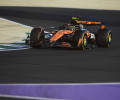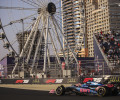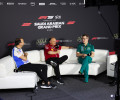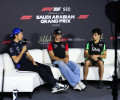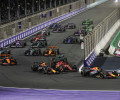2013 Monaco Grand Prix - Thursday Press Conference

TEAM REPRESENTATIVES – Christian HORNER (Red Bull Racing), Paul HEMBERY (Pirelli), Gerard LOPEZ (Lotus), Robert FEARNLEY (Force India), Franz TOST (Toro Rosso), Alain PROST (Renault Sport)
PRESS CONFERENCE
Alain, it’s been a while since we last saw you in an FIA press conference, welcome. Explain a little bit about your role with Renault Sport?
Alain PROST: Well, my role is mainly is an ambassador for Renault, the brand Renault, since last year. Even if I have done many things with Renault in the last few years, for different things. Also this year I’m advisor for the strategy, being part of the executive committee.
In terms of 2014, how far advanced is Renault’s programme?
AP: Everything goes well. The engine should run in June on the dyno, the final version. But everything is belonging to the programme.
And when do you think that Renault Sport will be finalising its teams for 2014?
AP: I’m not myself negotiating with the teams but we all know that it’s going to be accelerating during this weekend. I don’t know. I cannot say all the dates for all the teams but I hope very quickly.
Paul, if I could turn to you next. An awful lot of debate and opinion in Formula One at the moment regarding the Pirelli tyres this year, some pro, some anti. What is your opinion on the way that the Pirelli tyres are influencing the racing, and also what changes will we see to the tyres from Canada onwards?
Paul HEMBERY: Well, obviously there’s a lot of different opinion, quite divided, among fans, commentators, teams and you’re never going to please everyone. That’s one of the challenges you have but from our point of view it’s the same for everybody, they have exactly the same tyres to work with and somebody’s going to end up winning on a Sunday. From Canada? Well, we’re still finalising the ultimate details for Canada. We’re trying to minimise the changes, for sporting equity reasons of course. We want to resolve the delaminations that we’ve seen, that have occurred when we’ve picked up debris. That, from a tyre maker of course is something that we’ve wanted to solve. It doesn’t look good. The tyres have stayed inflated but it still doesn’t look good from an image point of view. So that’s where we’re at. We’re trying to finalise that, working with the teams. We’ve had good collaboration. Of course, some people might want something different and again you’re not going to please everybody but we have to do what’s correct for the sport and what’s correct for Pirelli.
While we’re talking tyres I think it would be nice to get the reaction of the team principals and chairmen here on the panel. Christian, can I start with you. What’s your opinion on the Pirelli tyres and the racing this year?
Christian HORNER: I think we’ve been pretty consistent throughout the year really. The tyres, on occasion, have been a bit too marginal. That includes races we’ve won at in Malaysia and Bahrain. I think it’s good that Pirelli are looking at it. I think the most important and most fundamental thing is from a safety perspective, if you do have a delamination, if you have a big chunk of rubber, you don’t want that to hit a car component or worst case a driver. So, there are safety issues that I know some of the drivers are concerned about. Hopefully, Pirelli are a very capable company. I think they know what they need to do and hopefully that can be resolved very quickly.
Gerard, is that an opinion your share – that the tyres have been too marginal this year?
Gerard LOPEZ: Yeah, we’ve echoed the safety issues and said that whatever needs to be done on safety grounds is obviously fine with us, we’re not going to go against that. As far as the tyres being marginal goes, we’ve found them to be quite consistent. But then again – different cars, different drivers, different styles… they work for us. So we’re actually quite happy with the way they are.
Franz, what about you and Toro Rosso?
Franz TOST: I think the problems started in testing, because in February it was very cold when we were out the first time this year and if I remember only Jerez was an acceptable test but otherwise in Barcelona it was quite cold. There we couldn’t do a proper test for the tyres. I think if we had tested in a warmer country some of the problems we observe now could have been sorted out. Therefore, I hope that in future we will do these tests under other conditions, under conditions under which we are racing and then I think Pirelli immediately will react and will come up with a proper solution. So far we at Toro Rosso haven’t faced bigger problems.
Finally to you Bob. From a deputy team principal’s perspective: safety, racing, what’s your opinion:
Bob FEARNLEY: I think Pirelli have done a good job. Fundamentally we’re looking to try to average out at two to three stops per race and I think if you take the extremes in any 20-race series you’re going to have some that might do four and some that might do one. But overall were going to achieve the objective. I agree with Paul, it’s the same for everybody. I think some of the teams will have put in resource perhaps this time year to start looking at how they’re going to develop their car, what suspension programme they’re going to put in to optimise the tyres, other teams will continued to work on aero. That’s the choice of the teams at the end of the day and you’ve got to deliver what you think is the most competitive package. But there are four points of contact on a track, it doesn’t matter how much else you do, you’ve got to make the tyres work.
Alain, I’m sure you’ve been watching the racing quite intently. Has the sport got the right balance at the moment between exciting racing or tyres dominating too much?
AP: I think in the past and very recently it’s been very [much] criticised for not having a show or indecision. We should [feel] very lucky that we have these kind of races. In the last few years, we have the decision only in the last grand prix. Obviously, also think about next year when we have the new engine coming we will talk maybe a little bit more about the engine, the technology, about being much closer to the product of the automotive industry. But we still need to keep the show also. We need to keep the indecision so it’s going to be even better balanced but at the moment I wouldn’t criticize what we have today.
If I could move on and turn to you, Franz. Both of your drivers in their second year with Toro Rosso this season. What improvements are you seeing from Jean-Eric Vergne and Daniel Ricciardo and as drivers who have been part of the Red Bull driver programme, do you see something in either of them that suggests that they could move up to the senior team?
FT: Yeah I must say that both of the drivers have increased their performance and their understanding of the car of the technik, of everything, much during the last two years and they are still learning a lot. But I must say that so far they have done a reasonably good job and if we provide them with a good car, a good package, they are always able to score points. Of course, Daniel Ricciardo has a little bit more experience as he did already 11 races with HRT and you can see this. Jean-Eric Vergne is coming up with good technical feedback. He is learning also a lot. I expect from both of the drivers a very competitive second half of the season, once more if we provide them with a good car and then we will see how the future will be.
Christian, I’m sure as Red Bull team principal you keep an eye on all the young drivers in the young development programme?
CH: Yeah, absolutely. Both youngsters have been members of the Red Bull Junior team for quite a few years now and or course we watch their progress with great interest. They’re both young, talented drivers, both developing very well. It’s good to see. They’re both racing here on merit. For sure they’re two guys we have a watchful eye over.
Q: We’re getting to that stage of the season where traditionally you sit down, Red Bull, with Mark Webber and negotiate a new contract for next year, it’s normally towards the early part of the summer. Has anything been the case or has happened this season that might influence those negotiations? Will you be sitting down with Mark soon? What’s your thinking for the future?
CH: Well, we’re sitting here at race six, so y’know there’s still quite a few to go. But at the relevant time we’ll sit down with Mark and see what he wants to do, what his plans are for the future. Our interest is quite simple: we want the best two drivers in our cars going forward. Mark and Sebastian has been a tremendously successful partnership. It’s won three consecutive Constructors’ World Championships for us and obviously Mark’s made a significant contribution to that. At the relevant time – which isn’t now – we will sit down and talk about the future.
Q: Gerard, can we talk drivers with yourself too? Kimi Räikkönen has hinted recently that there are maybe a couple of options open to him for next season. He’s certainly being asked an awful lot about his future. I assume Lotus would like to keep him but realistically how likely is that?
GL: Well I think Kimi’s quite happy where he is right now. Knowing Kimi well, outside of the track too, he could just as well announce that he’s stopping altogether. So, I wouldn’t take any bets whatsoever. I think we’re looking pretty good in terms of keeping him, as long as he gets what he wants, including a performing car, which is what he really wants. For the rest, we’ll see. He for sure will tell you there’s no such thing as a pre-contract, only real contract, and we’ll sit down at some point in time and discuss the future with him. But everything is wide open on the one hand but on the other hand everything is looking pretty good for us to stay with us. So we’ll see.
Q: Do you feel external and internal pressure then? A) to develop a car that Kimi – and Romain – can perform in and b) is there external pressure from other teams who would be interested?
GL: I don’t think we need to put on any additional pressure, I think I put enough pressure on them to perform – but I think it’s good if you have a driver that really wants to have the best possible package and actually can make use of it – and Kimi certainly can. The other thing with Kimi is that he needs an environment in which he can function, and he certainly has that with us.
Q: Bob, turning to you, it’s been a very positive start for Force India this season. I wonder if the start changes the target and your goals for this year? Is fifth place in the Constructors’ Championship a realistic target given what’s happened so far?
BF: I think it’s one that we certainly should aspire to. It would be very, very hard to continuously compete with McLaren through the year but they’re also going to have some issues in terms of when they switch over to the 2014 car and, like all of us, when do we move those resources? I think a lot will depend on how far they’ve got with this car when they actually do that. But for sure, we’ve already amended our programs and our team principal is very keen for us to ensure we stay fifth.
Q: Finally on the subject of drivers, Alain, for French drivers in Formula One this season, we’re here in the South of France for the Monaco Grand Prix, do you see anything in those drivers that might indicate to you that one day they could be the next French World Champion?
AP: Difficult question! Because the last 20 years there have been announced many, many times a new French champion. Just let them work, y’know? There are four, we are very lucky to have four, different competitiveness in teams. Romain for sure is in the best position to win at least maybe the first race very soon. And just wait and see. Don’t put them under too much pressure, they have enough.
QUESTIONS FROM THE FLOOR
Q: (Kate Walker – GP Week) Question for everyone except Monsieur Prost. Going on the subject of the tyres, one of the things, one of the theories that we’ve had in the press room is that the part of the difficulty has been the lack of a more modern test car. You know we haven’t got the DRS, the KERS, the… everything’s a bit different. Have the teams considered investing in a Dallara machine – or similar – that Pirelli might be able to use that you can all agree on? Then that way no one team would have an advantage.
Christian?
CH: I guess the fundamental thing is we can never agree. Everybody agreed for Lotus to do the testing when they weren’t so competitive. Now they’re competitive and probably there’s a few teams that aren’t so happy that they’re not doing the testing. So, it’s a difficult one. It’s a difficult one for Pirelli, it’s a difficult one for the teams but at the end of the day we don’t need to make it too complicated. I think the way things are at the moment is too complicated for the fans. It’s too difficult to follow races where you’ve got four stops, going on. It’s hard enough when you’re in the race. I think we need to just wind that back a little bit and more than anything make sure we eliminate any safety issues.
Q: (Kate Walker – GP Week) That isn’t really what I asked. I was wondering what sort of things you guys as a group could do going forward to try and make sure the y’know, the focus of the… wasn’t necessary criticisms of the tyres but how you could actually improve them as a group so that everybody was happy with what they were running on?
CH: Well, I don’t think you’re ever going to get everybody happy. Y’know, that’s the fundamental issue and unless you open testing up again, where everybody tests, it’s probably very difficult because people’s cars behave in different ways. So I can’t see a situation where the teams will say ‘yes, we’ll jointly fund and run a car for a tyre supplier.’ I’d be surprised.
Franz?
FT: No, we should use Friday morning, the first session or the first half-hour for testing new tyres – not sitting around like today, doing nothing. People in the grandstands, no cars out there. We just could use this – it was half an hour or 35 minutes as usually – to test new tyres. This is what I suggest since two years.
Gerard, your thoughts?
GL: My thoughts are… I would agree with Christian on the fact that it’s really difficult to get everybody to agree on anything in Formula One – be it tyres or be it anything else. And I think it’s going to stay that way just because it’s competitive both on and off the track and so on. I remember when, indeed, when we were asked to propose a car – and by the way, that car has nothing in common with what we’re running now – everybody agreed and now suddenly everybody thinks that’s the mystery to knowing how to use those tyres. And as I said, both cars are completely unrelated. So it’s very difficult to get anything done that everybody accepts. Maybe a solution like running Friday tests, I don’t know – but even that requires everybody to agree and some will and some won’t. And so I think that’s always going to be part of Formula One: The fact that this is agreement and disagreement and that’s the way forward I guess.
Bob?
BF: I think Franz’s idea’s got a certain amount of merit. I’d love to endorse that with the element of having young drivers in there as well, just so that it ticks two boxes. But I think that Pirelli have a great deal of resource, as we all do outside of actually track testing. And for instance, even with the incidents that we’ve had with the delamination, a lot of it can be done on rigs and everything else – and I think that’s where most of it will be done in the long term.
So Paul, how difficult is the job that Pirelli have without the facilities to test in the way that was traditional in Formula One?
PH: Well, it’s one of those cases where you’re damned if you do, damned if you don’t. You’re clearly not going to get everyone to agree, and with a tyre, certainly if you design it around a certain application you can make a certain vehicle go quicker – and that’s clearly why we’re wanting to make changes now. Some people want more changes, some people don’t want any changes for example. The Friday is useful where you’re coming to a point of wanting to actually introduce a change – but you can’t go testing with 11 teams on a Friday with various specifications because it simply doesn’t work that way. I think a good step forward would be winter testing actually in hot conditions. Y’know, if we were able to get to Abu Dhabi or Bahrain before we get to Australia, at least you’d have an advanced indication. You’ve also got to remember, if we do find surprises, and I’m quite sure next season there could be – assuming we have a contract which we don’t have at the moment – but assuming we’re going forward, you could get to a situation with the new powertrain, which from the indications of the teams will have a lot of torque, and will increase wheelspin, tyre wear, overheating, you could end up in a situation with a surprise again. So there needs to be a balance. Teams have clearly got restrictions on resources. The test teams were got rid of for good reasons from their point of view – but some sort of mid-range solution would be useful to us, even if it means staying on after a few events during the season, then that would be extremely valuable from our point of view.
Q: (Dieter Rencken – The Citizen) Alain, as Renault Sport brand ambassador, how do you feel about the fact that the public perception is that in fact Infiniti won the championship last year as the engine supplier because if one looks at the team principal’s shirt, there are five Infiniti badges and two Renault badges, yet Renault seems to be paying it all. How do you feel about that?
AP: I know it’s very difficult... it’s always difficult to answer this kind of question for me. The perception you can have here is obviously the right one, could be the right one. The involvement of Renault in Formula One, is very clear over the last few years. As you can see, the market in Europe is not very good and they’re already aiming for having a new image, new visibility in new markets: Russia, Brazil, India and a little bit less in China, those are the big markets for Renault. Obviously everybody would like to maybe have a different situation for Renault inside Formula One, for example, again, a new team, a Renault team, but the strategy of the president and of Renault is very clear. They want to stay the way they are at the moment and I must say that in this country they were talking about how it’s working very well and they’re increasing the image of the brand and they’re selling more and more cars and they want to continue like this. As I said, the perception you can have here maybe is a bit different to what they achieve instead of having a proper team, more aggravation. Again, talking about strategy, if you see what Renault has done in the last 37 years, they went from the French national team to being a partner with Williams and Benetton and then another team and then now they are supporting a team with whom we have won the World Champion for the last three years. So they could change, they could maybe change in the future, but at the moment we need to keep to this strategy decided by the president.
Q: (Dan Knutson – Auto Action/National Speedsport News) A question for Alain: there’s a lot of talk these days that the drivers cannot drive 100 percent flat out for the whole race Let’s take a year when you had a good car, say 1985. How much of the race could you drive 100 percent flat out? When you weren’t driving one hundred percent, what percent were you at and what parts of the car did you have to conserve, to make sure they lasted the race?
AP: I think it’s difficult to compare, obviously, because today the cars are so advanced; normally the driver can push 100 percent in normal conditions. The tyres this year are very soft which makes it a little bit different. In our time, if you want to compare, we had to take care of the brakes and gearbox and fuel consumption and obviously also tyres because sometimes we had to be careful of the tyres, but the regulations were also very different and at one stage we had three types of rubber and we could make changes and I very often ran hard tyres on the left and soft tyres on the front. I even raced in Las Vegas in ’81 with qualifying tyres on the front, but that means we cannot compare, but that also proves that you need to adapt yourself, as a driver, as an engineer, to the regulations and obviously we’re experiencing complaints this year... in fact it’s not that different compared to last year, except that you maybe don’t want to see some rubber on the track and having accidents. But apart from that, you just have to adapt to the situation, drivers or engineers. It’s typically Formula One.
Q: (Alan Baldwin – Reuters) Christian, I may have misconstrued your comment earlier but do you seriously believe that Lotus have somehow benefitted from the fact that Pirelli are using a 2010 Renault for testing, and maybe Paul could answer whether privileged information has somehow been given to one team?
CH: No, I don’t think privileged information or anything in any way has been done underhand. At the end of the day, Pirelli needed a car to test, they originally came to Red Bull. At that time, it was almost unanimously agreed that Red Bull shouldn’t provide a car and then it was a matter of finding who could provide a car. Lotus was an obvious choice. Running had to be done by Pirelli with drivers that weren’t current race drivers. You can understand that that work has had to be done. I wasn’t trying to point out that there was any specific advantage from that, I was trying to point out that you’re always going to struggle to achieve compromise and agreement.
Q: Given the changes between 2010 and now, Paul, how different is your test car to what we would see on the track?
PH: They’re probably, in terms of performance, closer to the 2011 cars with the blown diffusers. They’re going, certainly, a little bit harder than we anticipated this season. We’re probably lapping our 2010 car three to four seconds slower, for example. That gives you an indication that we’re not stressing the tyres during our testing as much as the cars are today. But there’s not a perfect solution to that. We’re not going to get unanimous agreement from everybody. Next year, the cars are so different that there’s really nothing available today, even including today’s cars, that would allow us to simulate the effect of the new powertrain. I think if we just take a sensible approach, in terms as I’ve already mentioned, of the winter testing and the potential to make adjustments during the season, but bear in mind you need agreement, you need eleven teams to agree to adjustments so if we’ve something that’s affecting eleven teams, then that’s really often easy to do. If you’re making something that might affect some teams and not all teams or perceived benefit to others then you can imagine that’s difficult. So that’s a very strange balancing act that we’re trying to do. We agree, we set out this year for two to three pit stops over the season, we probably will average that still, we will get some races like Barcelona which was won this time with four stops. It was won two years ago by Red Bull with four stops so it’s not exceptional but I guess as commentators it’s harder to follow, it keeps you awake, you don’t have your afternoon snooze any more, and that’s one of the difficulties. It will be easier here for you.
Q: (Jerome Pugmire - Associated Press) Alain Prost, it’s not been since Olivier Panis in 1996 for a French driver. What advice would you give Romain Grosjean, for example or the other French drivers... the frustration about that long spell, what advice would you give to them?
AP: I don’t think you can give advice to the drivers to be honest. They know what they do, I’m out of Formula One as a driver for the last 20 years exactly and why should I give advice to... we all see what is happening, we see that Romain, for example, has a very good car, he should be able to win a race very soon as I said. But no advice from myself. If they want to have advice they can ask a question and I’m happy to answer but not giving advice like this, no. Mental is a very strong thing for sure, but also we give them a lot of pressure very often, but this is a cycle. As soon as one is going to be winning, it could snowball and I hope it works like this.
Q: (Bob McKenzie – Daily Express) Alain, every year someone says that Monaco is too dangerous. This week’s hero was Ralf Schumacher. I wonder, it hasn’t really changed much since your day. Do you think it is too dangerous? Do you think it’s still a relevant place for a Formula One to be held?
AP: I wouldn’t say that. It’s as dangerous as another race track can be dangerous. It’s different, for sure. You have to be a little bit careful, especially in the traffic with all the cars. Being alone is not being more dangerous than with another car. I must also say that the passive safety, what they do with the marshals and all the work they have done in the last thirty/forty years, is exceptional and yeah, there are some conditions... when it’s wet in some places where it could be a bit tough but it’s such a fantastic race for everybody, especially for the drivers obviously. That is part of the tradition and you should accept it, even if it was a little bit dangerous, obviously. You should accept that.
Q: On the pit wall, is that a bit of a worry when you send the cars out?
BF: I think that Monaco represents the ultimate of the man and machine around a very difficult circuit and if I was a driver, I would relish the thought of it and I’m sure most drivers do. From a team point of view, it’s wonderful to see the cars on the limit so close to the barriers. It’s what we should be doing.
GL: Yeah, Romain came close to the barriers too. On another race track we would have gotten away with it, just overbraked and instead of trying to go straight on, decided he could take the corner and just took off a little bit of the left front of the car. I think the drivers love it. It’s a different track, they love it for the atmosphere, they love it for the excitement. If you talk to the drivers it’s quite an amazing experience. I’ve driven it myself actually, it’s quite an amazing experience if you get really close. I remember one of Robert’s laps, he probably thought it was one of the best laps he ever did and it was here in Monaco, so I think drivers love it.
Q: (Rodrigo Franca – VIP Magazine) Speaking of 2014, what do you think about the improvement of the Formula One show and also, what is the biggest challenge for the teams and Pirelli for the new regulations of the V6?
FT: First of all, the new regulation is a big challenge from the technical side, because it’s a new engine, new air system, the complete car will be new and then it’s a challenge also from the financial side because everything is much more expensive. Whether the show will be improved or not I can’t say yet because it depends how good the different engine manufacturers work. If there’s one of them finding a special solution then we will not have such interesting races as we have now because these cars will be in front. If they are all nearly equal as is the case in the current races then I’m sure we will also have very interesting races in the future. Nevertheless, this is a new regulation and we have to get the best out of it.
Q: Challenge for Pirelli?
PH: A contract? A contract is probably the first one. If you follow the regulations, on the first of September we’re meant to define the specification for next year but as yet we don’t really have a full picture of what the cars are going to be like, so you can imagine there’s a certain element of shooting in the dark. Having said that, it’s a probably a year where we will probably step back, be cautious. There’s going to be enough going on for the teams next year as you just heard from Franz, all those changes. So I think it’s a year where we’ll be stepping back: zero degradation, no pit stops and they can do all the talking.
CH: It’s difficult to say. It’s a massive change, probably the biggest change Formula One’s seen for probably the last 25 years, I would have thought. It’s hellishly expensive, especially with trying to develop a car this year and design and produce a car for next year with the changes that have been introduced, the timing of which probably isn’t ideal for some of the teams further down the grid. It’s a big regulation change. I think you’ll probably see significant differences between the teams early on but that will then converge and engineers will undoubtedly be very creative with the solutions that they come up with. It’s going to represent a different challenge, a different type of racing as fuel economy will suddenly become a premium point. We’re yet to see what affect that will have on the racing. At the moment, we’ve very much got an open mind.
GL: I would agree, the timing is... I don’t know if it’s well chosen. It’s certainly odd. We can understand the engine manufacturers who are trying to have a product that is closer to what people are buying out on the streets. At the same time, there comes a point where Formula One was doing really well in terms of excitement, in terms of cars being matched, in terms of races being open, so let’s hope that it doesn’t reshuffle the cards in a way that is... unexpected would be good but unexpected with huge gaps would be really bad. I don’t think any of us can really say today what the effect is going to be, so that’s it, a little bit of an unknown for everybody.
BF: Yeah, I think that we won’t be having discussions about tyres next year, it will be a completely different programme.
Q: (Ian Parkes – Press Association) Paul, you’ve talked about changing or tweaking the tyres from a safety perspective yet when we discussed the matter in Barcelona, you said that there had been no more failures this year than in previous seasons, so are you genuinely changing the tyres for safety aspects or are external pressures being brought to bear from other more powerful teams?
PH: No, I think the team pressure is something that is really in the media rather than a reality. I think that if you’re a tyre maker and the mode of failure this year is more dramatic because the tyres aren’t deflating they’re actually cutting into what we have now is a high tensile steel belt, that creates an opening that overheats and then creates what you’ve seen with the delamination. That’s something that’s not very good from a tyre maker’s point of view and we wish to get rid of so we need to do it for good reason. I think every team would agree with that. So you’ve got to try and do it though with a minimum amount of change because there’s a number of teams that have taken an approach this year that’s different. They decided early on what the challenges of the tyres would be this year and quite rightly they’re saying OK, change but don’t make it so dramatic, so that’s the situation we’re in and we’re closer to finalising the changes for Canada and that should be the end of it.
Q: (Dieter Rencken – The Citizen) Alain, when we spoke a year ago here you said that what ultimately pushed your team, Prost Grand Prix, out of business was the engine costs. We’ve heard quite a few people here talk about engine costs next year. Renault, in particular has come out and said that their price will be between 20 and 25 million which is a 250 percent increase over the current price. What do you say to that? Is there a chance, do you think that teams could go out of business because of engine prices next year?
AP: It is a problem, it’s first of all part of negotiation and the price you’ve said is much higher than it is in reality, but again, I’m not the one negotiating. Your reference with my team is obviously a good reference. I was paying 28 million dollars for the Ferrari engine in the first year and I was supposed to give 32 million the year after. I had to pay this money but I had to give a guarantee and pay almost cash before. That was in September, October or November, I don’t know. Why I say that because it’s always a way of trying to get the best for the general interest and we will see what is going to happen in negotiation but also you need to know that the budget of Renault Sport F1 is 150 million euros per year, and you can imagine... if you just make a very quick calculation about the price you can imagine divided by four teams, for example, and you will realise that Renault is paying a big contribution.
Ends

 Facebook
Facebook Twitter
Twitter
